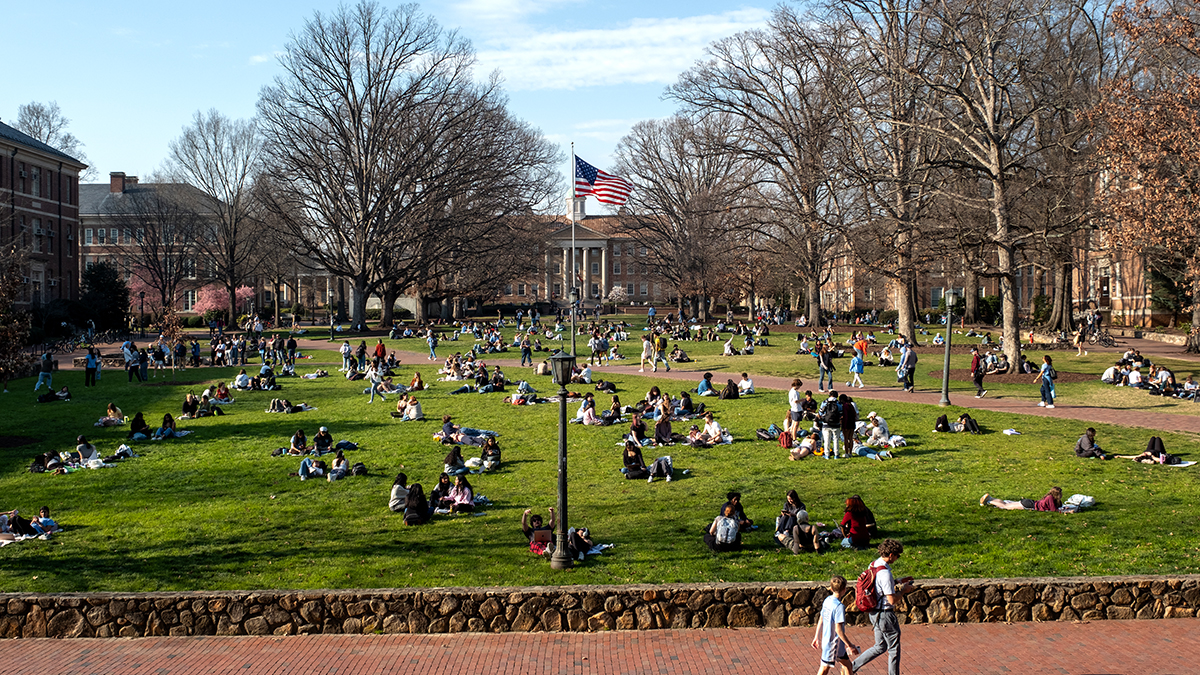‘Built from a dream’
Chancellor Carol L. Folt said no other university in America has had a longer, closer or more enduring bond with its home state and its governors than Carolina has had. That relationship was evident when two of North Carolina’s governors joined Folt on the stage of Memorial Hall on Oct. 12 to help celebrate Carolina’s 221st birthday.
Chancellor Carol L. Folt said no other university in America has had a longer, closer or more enduring bond with its home state and its governors than Carolina has had.
That relationship was evident when two of North Carolina’s governors joined Folt on the stage of Memorial Hall on Oct. 12 to help celebrate Carolina’s 221st birthday.
Former Gov. Jim Hunt was there to receive a Distinguished Alumnus Award. Current Gov. Pat McCrory delivered the keynote address that served as a call to action for Carolina to lead the innovation and research efforts needed to fuel North Carolina’s future and help the state realize its potential, particularly in the area of cutting-edge technology.
In the year Folt has served as Carolina’s 11th chancellor and McCrory has been North Carolina’s 74th governor, they have built what Folt described as a strong and collaborative relationship. McCrory pointed out that both leaders faced a common challenge when they took office: they were called upon to solve problems not of their own making.
McCrory began his term with an ailing economy and what might have felt like a deck stacked against him. He ticked off the issues he faced: repaying a $2.5 billion federal debt for unemployment insurance, replenishing a depleted rainy day fund and addressing what he called a $530 million misforecast of the state’s Medicaid costs, while finding a way to provide teachers with the first substantial pay raise they have received in years.
Folt arrived to face the challenges of a University whose academic integrity was in question. Referring to Folt’s leadership, McCrory said, “Your new chancellor also inherited consequences of pockets of bad policy and, frankly poor oversight, that did not meet the standards or ethics of this great university.”
He added, “She has done an excellent job in listening, taking charge and making much-needed change.”
As current issues are addressed, McCrory said, it is also important to focus on long-term strategies to fulfill the state’s potential.
He challenged the audience to consider what the intellectual purpose of universities should be and the return expected of them, given North Carolina’s financial investment in its resident undergraduate students: $22,000 per student per academic year.
“Our universities must continue to be an environment where our students can exercise their brains, be free to think, explore, solve problems, adapt and innovate,” he said.
That process of growth and exploration is what a liberal arts education is all about, McCrory said. But he added that higher education must do more, not only to lower students’ debt at graduation and raise their prospects for a job offering a competitive salary, but also to help ensure that companies can find workers with the skills needed to meet the complex demands of 21st-century jobs.
“Innovation is the fuel of the modern American economy,” he said, and Carolina has an important role in helping the state focus on long-term strategies to fulfill its potential in health care, commerce, transportation and education.
“Chapel Hill is the pinnacle,” McCrory said. “It is the benchmark for all of education in North Carolina. It is the place where the brightest from across the state, the nation and the world come to learn.
“It is the place where the best of the best come to fulfill their potential. It is where our future scientists, lawyers, teachers, inventors, entrepreneurs and leaders formulate their initial dreams and visions.”
“With one brick,” Folt said, William Richardson Davie dreamed us into being,” on Oct. 12, 1793, with the laying of the cornerstone of Old East and the founding of public higher education in America.
Each subsequent generation has added more bricks to that foundation, extending Carolina’s reach across the state and around the world.
“Our early leaders could not have imagined the ways in which we could change and grow, but they created the opportunity for it to happen,” Folt said.
The University’s history, Folt said, was “built from a dream” that came out of the Revolutionary War and rose from the woods that became Carolina, and that still could be felt in the trees that stood long before Old East.
With daring vision, Davie, who would go on to serve as North Carolina’s 10th governor, introduced a revolutionary idea of a public university created for the people of the state that would mirror the ideals of a hard-won democracy.
That spirit has endured, and “today, we are living the next chapter of our visionary’s dream,” Folt said.
It is that same spirit that guided President Henry Chase in the first half of the 20th century when he led Carolina to national prominence as an exemplar of the modern university. “He saw what others did not – he did not give in to despair, but guided us to a prominent future,” Folt said. “And the history he created still drives the future we live.”
McCrory said he envisions North Carolina’s potential to become a vertex of what he called America’s innovation triangle, with Silicon Valley and the Boston-New York City corridor.
For that to happen, he said, it will take collaboration among the state’s leading universities, with Carolina showing the way – as it has always done.
“It is the job of this governor – and of your incredible new chancellor and each one of you – to strengthen, reform and adapt the UNC brand and heritage to the ever-changing competitive environment of the 21st century,” McCrory said.
Click here for text of Folt’s University Day speech.




